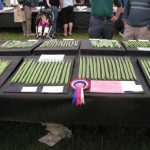
John Trim
Champion show grower John Trim runs us through the details of cultivation of exhibition runner beans for the show bench in this second article of three on show growing runner beans.
This is Part Two of Three Parts on Exhibition Runner Beans:
- Exhibition Runner Beans for Horticultural Show
- Cultivation of Exhibition Runner Beans for Horticultural Show
- Staging of Exhibition Runner Beans for Horticultural Show
Planting out your Runner Beans
Once you have raked in the fertiliser to the soil surface it is time to erect supports for the beans to climb up. Beans for exhibition are grown on the cordon system. Metal or wooden posts are firmly positioned at each end of the trench and a straining wire is attached between them.
Posts will be required every 8’ / 2.4M as there will be a lot of windage once the beans are fully grown. Every 18”/45cm clip or tie an 8’ tall bamboo cane to the wire. These can be positioned upright or at an angle so that the beans hang away from the foliage.
Set out one plant per cane and wind the growing point around the cane in an anti clockwise direction. Hold the growing point in place for a count of 20 seconds and the stem will stay in that position.
After frost, wind damage is the worse enemy of the young runner beans, erect a plastic screen a meter high around the plants until they are well established. This also creates a micro climate and helps to stimulates growth.
Care of the Runner Bean Plants

Well Matched Exhibition Runner Beans
As the bines (main stems of the plants) grow they throw out side shoots and flower stalks. All of these should be pinched out from the bottom 2’ 6” (75cm) of stem. There after allow flower stalks to form but continue to pinch out all the side shoots.
This has the effect of directing all the plants energy into fewer beans and hence they will grow longer. It is rather like thinning apples or plums for a heavier crop.
Do not go overboard with watering in the early stages of the beans life. Wait for bean set then you can’t give them enough. Early on we want the plants to search for water and in doing so create a strong root system.
When the bines reach the top of the cane pinch out the growing tip. This will help to induce flowering and bean set.
Generally beans do not suffer from much in the way of disease, they may have the odd attack of bean rust which is an air borne fungus that generally occurs late in the season or halo blight, but these occurrences are fairly rare. They are more likely to be attacked by pests.
As young plants they are most at risk from slugs so keep those pellets handy. As the plants grow it is usually black fly that make an appearance. Check under the leaves for that is where they first appear.
A small infestation can be washed off with the hose or rub them off using a flannel soaked in warm soapy water. If you have to spray with insecticide do this late evening when the ladybirds are abed.
Runner Bean Setting Problems
In hot weather bean set may prove difficult. Efficient pollination can only happen if the night time temperature falls below 60f/16c. If the temperature is consistently above this it inhibits the pollen grains from germinating. To assist germination hose the plants down with cold water in the evening.
Red flowered varieties suffer most from this condition in hot weather. White or bi-coloured varieties cope better as they are self pollinating. Unfortunately the white and bi-coloured varieties do not have a suitable contender for exhibition.
Pick off all beans that are over size and thin each hand of beans down to threes. Also remove the remnants of the flower from each bean as this could induce curling. As the beans grow remove any leaf they may touch or rub against. We want them to grow as straight as possible.
A hand of 3 or 4 beans can become quite heavy as they approach full size and the weight of them will often bend or even snap off the stalk. Tie each developing hand to the cane with string. This will also hold the beans clear of the surrounding foliage.






